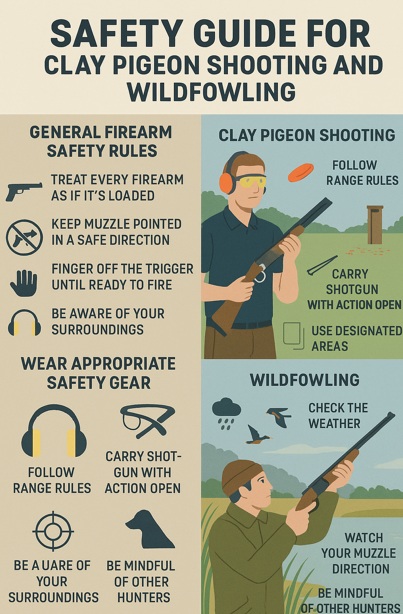Safety Guide for Clay Pigeon Shooting and Wildfowling
Safety is paramount in any shooting sport, whether you’re enjoying a controlled session of clay pigeon shooting or heading into the wilderness for a day of wildfowling. Proper handling of firearms and adherence to safety protocols not only protects you but also ensures the safety of others and preserves the integrity of the sport. This guide outlines essential safety practices for both clay pigeon shooters and wildfowlers.
General Firearm Safety Rules
- Treat every firearm as if it’s loaded: Always assume a shotgun is loaded until you’ve personally checked it.
- Keep the muzzle pointed in a safe direction: Never point the muzzle at anything you don’t intend to shoot.
- Finger off the trigger until ready to fire: Only place your finger on the trigger when you’re ready to shoot.
- Be aware of your surroundings: Know what’s in front of and behind your target.
- Wear appropriate safety gear: Protect your hearing with ear defenders and your eyes with shooting glasses.
Safety for Clay Pigeon Shooting
Clay pigeon shooting takes place in controlled environments, but safety is still critical. Follow these guidelines to ensure a safe and enjoyable experience:
1. Range Safety
- Follow the rules: Each shooting range will have its own set of rules. Familiarise yourself with them and follow them at all times.
- Listen to the Range Officer: They are responsible for maintaining safety. Follow their instructions immediately.
- Use designated areas: Only load and fire your shotgun in marked shooting stands or designated zones.
2. Handling Your Shotgun
- Carry your shotgun correctly: Always carry your shotgun with the action broken or the safety engaged.
- Load only when ready to shoot: Do not load your shotgun until you’re in the shooting stand and ready to fire.
- Check your ammunition: Ensure you’re using the correct cartridges for your shotgun.
3. Personal Safety
- Wear appropriate gear: Shooting glasses and ear protection are mandatory to guard against flying debris and loud noise.
- Check for obstructions: Always check that the barrels are clear before loading.
- Mind others: Ensure you’re aware of other shooters and spectators around you.
Safety for Wildfowling
Wildfowling presents unique challenges as it involves shooting in natural and often unpredictable environments. These additional safety measures are essential:
1. Preparation
- Check the weather: Avoid heading out in extreme weather conditions that could make shooting or retrieving unsafe.
- Plan your route: Familiarise yourself with the area and identify safe access points to marshes or estuaries.
- Tell someone your plans: Inform a friend or family member about your location and expected return time.
2. Equipment Safety
- Inspect your gear: Ensure your shotgun is in good working condition before heading out.
- Carry the right ammunition: Use cartridges suitable for wildfowling, such as non-toxic shot for waterfowl.
- Waterproof your gear: Use waterproof cases and clothing to protect your equipment and yourself from the elements.
3. Field Safety
- Be mindful of other hunters: Maintain a safe distance from other wildfowlers to avoid accidents.
- Watch for dogs: If using a retriever, ensure they are trained and under control at all times.
- Avoid overloading: Only carry as much equipment as you can safely manage in rough terrain.
4. Environmental Awareness
- Know your target: Always positively identify your target before firing to ensure it’s legal and ethical.
- Respect boundaries: Stick to permitted areas and avoid trespassing on private land.
- Clean up after yourself: Collect spent cartridges and any other litter to preserve the environment.
Common Safety Mistakes to Avoid
- Failing to check your shotgun: Always inspect your firearm before use to ensure it’s in safe working order.
- Ignoring safety zones: Whether on a clay range or in the field, always shoot within designated areas.
- Poor muzzle control: Always be aware of where your muzzle is pointing, even when your shotgun is unloaded.
- Overconfidence: Never assume you’re immune to accidents. Follow safety rules every time.
- Neglecting weather conditions: Especially for wildfowling, unpredictable weather can turn a safe outing into a dangerous situation.
Emergency Preparedness
For Both Disciplines:
- Carry a first aid kit: Always have basic first aid supplies on hand.
- Know emergency contacts: Be familiar with local emergency services or the nearest medical facility.
- Have a communication device: Carry a fully charged mobile phone or radio, particularly when wildfowling in remote areas.
Wildfowling-Specific:
- Carry a whistle: A simple whistle can help alert others to your location in an emergency.
- Learn basic survival skills: Knowing how to navigate, build shelter, or signal for help can be lifesaving in remote locations.
Conclusion
Whether you’re a clay pigeon shooter or a wildfowler, prioritising safety ensures not only your well-being but also the enjoyment and sustainability of the sport. By following these guidelines and always respecting your firearm, the environment, and those around you, you can shoot responsibly and confidently.
For more detailed advice, consider attending a safety course or speaking with experienced shooters at your local club or wildfowling association. Stay safe and enjoy your shooting!

